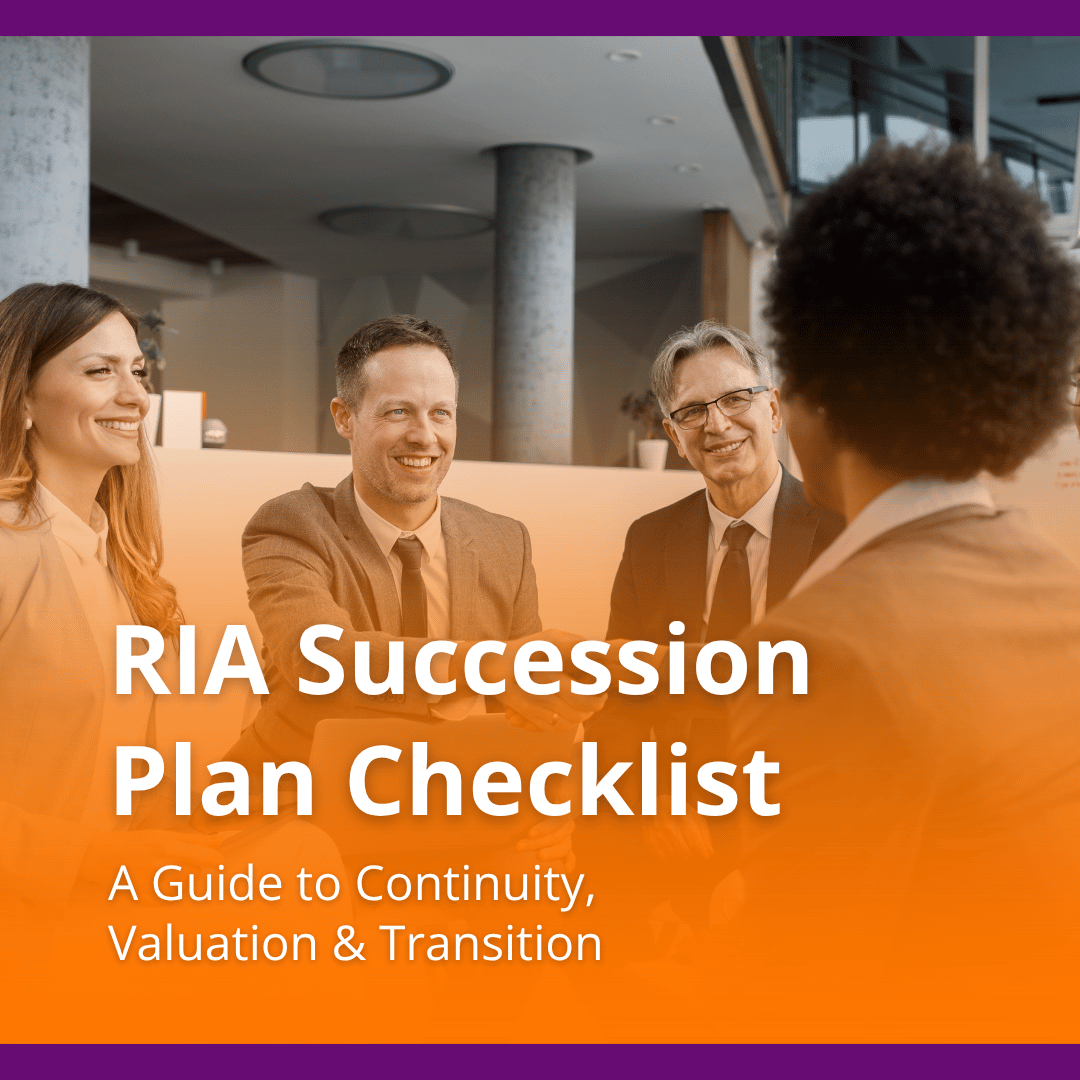Thinking of Selling Your Business? Document Your Operations First
Running a business means knowing every moving part. But to a buyer, that knowledge means nothing if it isn’t documented. And that’s a...
Comprehensive, data-driven valuations and comparative equity analyses to accurately price your practice, establish market benchmarks, and support informed decision-making.
Comprehensive M&A guidance encompassing deal structuring, negotiation strategies, market listings, and transaction closings.
Comprehensive systems, targeted coaching, and in-depth assessments designed to optimize operational efficiency and enhance advisory team effectiveness.
Strengthen continuity through the implementation of formal continuity agreements, the establishment of legal entities, execution of enforceable legal contracts, and securing appropriate capital resources.
11 min read
 Anthony Whitbeck, CFP®, CLU®
June 30, 2025
Anthony Whitbeck, CFP®, CLU®
June 30, 2025

Is your RIA prepared for the succession cliff?
According to DeVoe, only 42% of firms have written succession plans in 2024—the lowest percentage recorded since tracking began in 2019. That decline comes at a time when expectations for leadership transitions are rising. Many advisors assume their firm will be passed to an internal successor, but without a formal succession plan in place, that transition is often delayed, derailed, or undervalued. The result is increased risk to client relationships, firm valuation, and team stability.
Most RIA principals invest decades in building their practices, yet wait too long to address succession and continuity planning. When a timeline is forced by illness, burnout, or an unexpected offer, the result is often a rushed exit with preventable consequences. Clients want assurance that their financial advisor has secured a plan for the future. Staff need transparency on ownership changes and long-term roles.
This article provides a step-by-step framework for RIA owners to build a succession strategy aligned with their personal and business goals. It explains how to assess valuation, evaluate exit models, select the right successor, and reduce transition risk through continuity planning.
Download Advisor Legacy’s free RIA Succession Planning Checklist to guide your firm through each stage of the process.
Successful RIA succession planning begins with a clear vision for the future. You need to consider what you want your exit to look like, both professionally and personally. This early introspection is crucial for shaping your overall succession plan. Understanding your desired outcome will influence every subsequent decision, from the choice of successor to the financial performance you aim for prior to exit.
Consider your aspirations for stepping away from the RIA firm. Are you looking to fully retire, or do you intend to stay involved in a limited capacity, perhaps as a consultant or a board member? Do you envision an outright sale, a gradual reduction in ownership, or a "sell and stay" arrangement where you transition responsibilities over time while retaining some equity or a specific role? Think about your ideal timeline—is it a two-year sprint to the finish line, or are you planning for a ten-year runway that allows for a more gradual handoff and mentorship? Your answers to these questions will significantly influence the succession plan you develop, dictating the urgency and complexity of your preparations. A well-defined timeline helps set realistic expectations for all parties involved and guides the selection of the most suitable succession models that appeal to your circumstances.
Beyond the professional aspects, reflect on your personal lifestyle goals post-exit. Do you dream of extensive travel, more time with family, or pursuing new ventures like consulting, teaching, or philanthropy? Perhaps you envision dedicating more time to hobbies or community service. Determine the level of income or liquidity you'll need from your business succession to comfortably sustain that desired lifestyle without financial stress. A clear picture of your post-exit life will inform your financial requirements and guide your succession plan, ensuring the sale of your RIA truly supports your aspirations. This vision also helps in prioritizing whether maximizing the sale price or achieving certain non-financial outcomes, such as preserving culture, is more important.
It is essential to understand how much you need from the sale of your RIA firm to secure your retirement and achieve your personal financial goals. This involves a detailed assessment of your post-retirement expenses, desired income streams, and any legacy planning considerations. Decide whether maximizing the sale price is your highest priority or if preserving the firm's culture and values, ensuring client relationships continue seamlessly, or providing opportunities for clients and employees holds greater importance. Often, a balance must be struck. A common planning mistake to avoid is delaying action too long; the valuation of your advisory practice can decline as you approach retirement without a clear plan in place, potentially compromising your financial security. Proactive planning today allows for strategic moves that can enhance value.
Your succession plan should reflect your unwavering commitment to client service and your dedication to your team. Do you want your clients and employees to continue receiving the same level of service, adhering to your firm’s philosophy, and maintaining the trusted relationships you've cultivated? Are you aiming to preserve jobs, promote from within, or merge with a like-minded RIA that shares your culture and values? These preferences are not just ideals; they will directly shape how you evaluate various succession models' appeal and pathways. For instance, if preserving internal opportunities is paramount, internal succession might be favored. If a broader service offering is desired for clients, a merger with another RIA could be the best path. Make these preferences part of your early planning process—they will inform your selection of a successor and define the ultimate vision for the firm.
Understanding the business worth of your RIA is a foundational step in effective succession planning. This valuation will influence your strategic choices, potential pathways, and the financial outcomes for your long-term financial security.
Relying on simple "rules of thumb" for your RIA firm's valuation can lead to significant inaccuracies and missed opportunities. A professional valuation goes far beyond these generalized metrics by analyzing critical components such as your firm's recurring revenue streams, profitability (EBITDA), client demographics, operational efficiency, and the quality of your investment management processes. For example, Advisor Legacy offers an award-winning valuation approach tailored specifically to RIA firms, providing a detailed and defensible assessment. A thorough valuation provides an objective assessment of your advisory practice’s true business worth, enabling you to negotiate from a position of strength and make informed decisions about your future.
Several elements contribute significantly to the valuation of your RIA firm. A younger, growing client base with strong retention rates and a high percentage of recurring revenue (e.g., AUM-based fees) typically increases value. Operational efficiency, reflected in streamlined processes and a well-structured team, also plays a crucial role. Other factors include the diversification of your client base, the robustness of your compliance framework, and the intellectual capital embedded within your firm, such as proprietary investment strategies or unique client service models. Strong client relationships, especially those that extend beyond the principal, and a robust assets under management (AUM) base are always key value drivers. A higher proportion of recurring revenue, for example, generally leads to a higher valuation because it signifies predictable future cash flows. Understanding these drivers allows RIA owners to focus on enhancing specific areas of their practice to maximize their market appeal before entering the succession phase.
A comprehensive understanding of your business's worth unlocks a broader range of exit options. Knowing your RIA firm's financial standing allows you to make informed decisions about whether to pursue an internal succession where you transfer equity over time, an external sale to another RIA or a larger entity, or a strategic merger. Each of these pathways has distinct financial implications and requires different preparations. For instance, if your valuation is higher than expected, it might open doors to more lucrative external sales. Conversely, if it's lower, it might necessitate an internal succession with a longer earn-out period to provide the successor sufficient time to build value. This knowledge truly shows how a plan creates possibility, empowering RIA leaders to select the option that best aligns with their personal and professional goals, ensuring they yield the highest benefit from their years of dedicated work.
There are several distinct succession models that appeal to RIA owners, each with its advantages and considerations. Selecting the appropriate pathway is pivotal for a successful transition, impacting everything from client experience to staff morale and your ultimate financial outcome.
An internal succession involves identifying and grooming junior advisors or existing employees within your firm to eventually take over leadership and ownership. This approach often includes structured mentorship programs, gradual equity transfer arrangements, and phased responsibility shifts. The primary benefits include fostering a strong sense of continuity for clients and employees, as familiar faces remain in charge, and helping to preserve the firm’s unique culture and values. Building confidence in younger advisors and encouraging active client introductions during the transition period are vital for this model’s success. It allows the successor to learn the intricacies of the firm’s operations and client needs organically, ensuring a smooth transition where the client relationships are maintained and deepened over time.
An external sale involves selling your RIA firm to an outside party, which could be another RIA, a larger financial institution, or an RIA aggregator. This pathway can often maximize the sale price and provide immediate liquidity. Key considerations for this pathway include cultural alignment with the acquiring entity, ensuring service continuity for your clients, and understanding how the new ownership might integrate your existing team. Many RIA owners find working under a larger umbrella appealing for operational efficiencies, expanded resources, access to new technologies, and potential growth opportunities. This option is frequently explored by many advisors looking to streamline their exit and potentially achieve a higher valuation than what might be feasible through an internal succession.
A strategic sale may involve merging with another firm that complements your services, expands your geographic reach, or brings specialized expertise. This can offer comprehensive M&A deal support and various ownership transition options, such as exchanging your firm's assets for equity in the larger entity. The goal is often to create a combined entity that is stronger and more valuable than the sum of its parts. Alternatively, a partnership might involve bringing in a new equity partner to help lead and grow the business, with an eventual plan for your exit down the line. This differs from a full sale as you retain a vested interest in the firm's future. These options require careful consideration of the firm’s future vision for the firm, including how services will be integrated, how staff roles might evolve, and how the combined entity will serve existing and new clients. It's about finding the right strategic fit to ensure both financial benefit and continued success.
Beyond a full succession plan, a continuity plan is an essential risk management strategy for every RIA. This plan details specific procedures and protocols for what happens to your business and clients in case of an unexpected event, such as your sudden illness, disability, or death. A written continuity plan designates who will manage client affairs, access critical information, and ensure the ongoing operation of the firm. It ensures the financial well-being of your clients and the stability of your firm, even if your comprehensive succession plan takes time to fully materialize. Continuity and succession planning are intertwined; a robust continuity plan can serve as an emergency bridge until a long-term succession plan can be fully executed. For instance, it can specify who takes over your investment management responsibilities and how client communication will be handled immediately. This ensures a sense of continuity even in unforeseen circumstances.
A well-documented and structured transition strategy is crucial for a smooth transition during RIA succession planning. This involves thoughtful decision-making, meticulous legal and financial structuring, and clear, proactive communication.
Understanding different deal structures is vital for RIA owners seeking to sell or transition their firm. Options can include a significant upfront cash payment at closing, which provides immediate liquidity; earn-outs, where a portion of the purchase price is paid over time, contingent on the firm's future performance; or equity stakes in the acquiring firm, which allows the selling principal to participate in the future growth of the combined entity. Each structure has distinct implications for risk, liquidity, and potential upside. Knowing what works best for your personal financial goals and risk tolerance is paramount. The chosen structure will directly impact your long-term financial security and how you perceive your business as compensation for your life's work. Consulting with legal and financial experts specializing in RIA M&A is critical to ensure the chosen structure is optimal and legally sound.
A carefully crafted client communication plan is essential to ensure a smooth transition and maintain trust. It's about passing the "grocery store test"—meaning your clients should feel secure, informed, and confident about the transition, even if they encounter you unexpectedly in public and ask about it. The plan should outline what will be communicated (e.g., continuity of service, shared values, benefits of the transition), when (phased announcements, one-on-one meetings), and by whom (initially by the selling advisor, then jointly with the successor). Clearly communicate the values, culture, and continuity of service to your clients. A transparent and empathetic approach helps maintain strong client relationships and ensures they continue receiving the service they expect. This proactive engagement can significantly reduce client attrition during the transition period.
Involve all key stakeholders early in the planning process to foster buy-in and minimize disruption. This includes your employees, key clients, legal counsel, compliance professionals, and potentially your custodian (such as with a Schwab custodial relationship). Employees, especially those who might become internal successor candidates, need to understand the vision and their potential roles. Clients benefit from early, transparent communication to ease any anxieties. Legal and compliance experts ensure the sale agreement and transition adhere to all regulatory requirements, mitigating future risks. Consider aspects like key person insurance to protect the firm from unforeseen events involving critical personnel, and retention planning strategies to ensure valuable staff remain committed during and after the transition. Early engagement fosters trust, collaboration, and a collective commitment to a successful transition.
Execution and ongoing monitoring are critical for the success of your RIA succession plan. A robust implementation phase ensures your strategy comes to fruition, adapting as needed to real-world developments.
Establish clear milestones and integration timelines for your succession plan. This detailed roadmap should include specific dates for valuation, successor identification, legal documentation, client communication phases, and financial transfers. Regular performance check-ins are necessary to ensure the transition is progressing as intended and to address any deviations promptly. This systematic approach helps identify and address any potential issues proactively, ensuring the perfect succession plan remains on track. For instance, if an internal successor is not hitting their client acquisition targets, adjustments to coaching or marketing support can be made. Consistent monitoring allows for flexibility and ensures the plan's objectives are met, leading to a truly successful transition.
For internal succession, dedicated coaching for the next generation of advisors is vital. This goes beyond technical knowledge; it involves transferring client relationship skills, firm management philosophy, and your unique approach to wealth management. Build confidence in younger advisors by assigning them increasing levels of responsibility, involving them in client meetings, and providing constructive feedback. Actively encourage them to develop their strong client relationships by facilitating direct introductions and gradually transitioning lead relationships. This hands-on mentorship ensures a seamless transfer of trust and rapport, which is essential for preserving the firm’s value and future client relationships. The goal is for the successor to fully embody the firm’s culture and values.
Leverage specialized tools and support resources to aid your succession plan. Professional firms like Advisor Legacy offer comprehensive deal support, unbiased valuation services, and targeted coaching specifically designed for RIAs. Utilizing such expertise can streamline the process, navigate complex negotiations, and lead to a more successful transition. For example, they can assist in creating a detailed written succession plan, support the due diligence process for a sale or merger, and provide ongoing coaching for both the exiting advisor and the successor. Firms with a Schwab custodial relationship or other major custodians can also find valuable resources and best practices related to RIA succession planning. These external resources provide specialized knowledge that can prevent costly planning mistakes to avoid and ensure compliance.
Even with the best intentions, RIA owners can make critical errors in succession and continuity planning that jeopardize their firm’s future and personal financial security. Being aware of these common pitfalls is crucial for a successful transition.
One of the most frequent and impactful planning mistakes to avoid is procrastination. Many advisors wait until they are too close to retirement, or until an unexpected event forces their hand. This leaves insufficient time to properly identify a successor, execute a thoughtful internal succession plan, or find the right external buyer. A rushed process often results in a lower valuation, suboptimal deal terms, and potential client dissatisfaction. A well-executed succession plan takes time—often several years—to develop and implement effectively.
Failing to secure a professional valuation is another common error. RIA owners might rely on outdated industry averages or anecdotal evidence, leading to either an overestimation that deters buyers or an underestimation that leaves money on the table. An accurate, third-party valuation provides a realistic baseline for negotiations and helps structure a deal that truly reflects your business's worth. Without this, you might not achieve the long-term financial security you envision.
A lack of transparency with clients during a transition can be devastating. Clients build relationships with their financial advisor, and a sudden, poorly communicated change can erode trust and lead to attrition. Failing to involve clients early or presenting the transition as a done deal rather than a thoughtful evolution can cause them to seek advice elsewhere. A strategic client communication plan is paramount to maintain client relationships and ensure continuity.
Whether pursuing an internal succession or a sale or merger, overlooking cultural alignment is a significant oversight. A mismatch in values, service philosophy, or even investment management approaches between the selling and acquiring firms can lead to staff dissatisfaction, client churn, and integration challenges post-transition. Ensure your successor or acquiring entity shares your vision for the firm and its commitment to client service.
While intertwined with succession planning, a separate and robust continuity plan is often overlooked. This plan addresses immediate, unforeseen circumstances like disability or death. Many RIA owners assume their succession plan covers this, but a long-term succession plan takes time to execute, whereas a continuity plan must provide immediate action. Without a written continuity plan in place, your business and clients could be left vulnerable, causing significant disruption and potential loss of value.
Succession planning for RIAs takes expert guidance, disciplined execution, and a structured approach tailored to your firm’s goals. Advisor Legacy works exclusively with independent RIA owners and financial advisors to design and implement effective succession strategies that preserve firm value, client trust, and internal culture.
Our team supports every phase of the planning process—from accurate valuations and written succession plans to continuity risk mitigation and M&A deal structuring. Whether you're preparing to retire, considering an internal successor, or weighing a merger with another firm, we help you move forward with confidence and clarity.
Succession planning isn’t a one-size-fits-all process. We take the time to understand your business, your priorities, and the legacy you want to protect. With the right plan in place, your clients and employees stay supported, your advisory practice retains its value, and your next chapter can begin without disruption.
Download Advisor Legacy’s free RIA Succession Planning Checklist to take the first step toward a smarter, more secure transition.
Anthony "Tony" Whitbeck, CFP®, CLU®, is CEO and Owner of Advisor Legacy. He began his career as a financial advisor in 1989 and later shifted to coaching, where he’s guided more than two hundred advisory practices through growth, valuation, and succession. Tony leads Advisor Legacy’s certified third-party valuation engagements and coordinates lending and legal partners to streamline transactions. His articles focus on building transferable enterprise value, mapping internal vs. external exits, and avoiding common succession pitfalls. Drawing on decades of in-the-trenches experience, Tony provides practical, compliance-friendly guidance advisors can use right away.
Receive timely articles, tip sheets, events, and more right in your inbox.

Running a business means knowing every moving part. But to a buyer, that knowledge means nothing if it isn’t documented. And that’s a...

Growing by acquisition is one of the fastest ways to scale — but it’s also one of the easiest ways to stumble. Behind every successful deal is a...

The M&A landscape in financial services isn’t slowing down. It’s evolving. Fast. As of mid-2025, deal values in the sector have surged by...